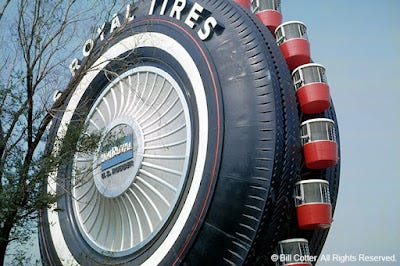#WorldsFair64: Uniroyal’s Giant Tire Ferris Wheel Was a Hit in New York and Later, Detroit

This giant tire was born as a World’s Fair Ferris wheel and became a Motor City icon.
by Rich Watson
Due to a dispute between the international sanctioning body in charge of world’s fairs and New York Fair Director Robert Moses, corporate sponsorship dominated the 1964 Fair. Lots of major businesses created pavilions for the event.
Among them included the U.S. Rubber Company, known today as Uniroyal. They took a creative approach into making something common to fairs everywhere: a Ferris wheel in the shape of a tire.
About Uniroyal
Since 1892, Uniroyal has manufactured not only tires, but other rubber-related items and military products, such as ammunition, explosives and chemical weapons. In 1986 they merged with B.F. Goodrich Company, who specialized in high-performance replacement tires. Four years later Michelin purchased them.
Ferris wheels and World’s Fairs
The concept of a Ferris wheel is believed to have originated in seventeenth-century Bulgaria. Other “pleasure wheels” cropped up here and there, including one in New Jersey as late as 1891. The modern edition, however, is commonly credited to the one that was part of a World’s Fair.
In 1893, engineer George Ferris designed a “Roundabout” as a means for the Chicago World’s Fair to outshine the 1889 Paris Fair, birthplace of the Eiffel Tower.
William Somers, the New Jersey wheel inventor, sued Ferris for copyright infringement. Ferris admitted in court he stole the idea. Though Somers won the trial, he lost the appeal.
The U.S. Rubber Ferris Wheel
U.S. Rubber’s original design was a giant tire, but not a Ferris wheel. It was a tire wrapped around a globe, to symbolize the car industry and its growth. They discarded the globe part, but the idea resurfaced as part of US Steel’s design for the Unisphere.
When U.S. Rubber hit upon the Ferris wheel-as-a-tire idea, the Fair guaranteed them exclusivity as the only Ferris wheel at the show. Shreve, Lamb & Harmon, the architectural firm who built the Empire State Building, designed the wheel with Hardesty & Hanover.
It’s made of fiberglass and steel, not rubber. Its diameter is eighty feet. It weighs twelve tons. Twenty-four gondolas could carry up to ninety-six people.
It was a quarter to ride (fifty cents in the second year) and lasted ten minutes. Among the two million who rode it included former First Lady Jacqueline Kennedy and her children. The Fair also sold a toy replica of the wheel.
After the Fair, in 1965, Uniroyal offered the wheel to New York as a donation. Moses, who was also Parks Commissioner, opposed anything that would turn Flushing Meadow Park into what he called “kiddie cities.” No one else wanted it, and the Fair‘s contract with Uniroyal stipulated the wheel, like every other Fair exhibit, had to be demolished or disassembled.
So they kept it.
A second life in Detroit
The Ferris wheel parts were gutted. Dismantled into pieces and shipped out of New York by train, the giant tire traveled to Allen Park, Michigan, a Detroit suburb. (The Flushing Meadow Zoo is now where the wheel stood.)
In 1966, they reassembled the tire and placed it near Uniroyal’s headquarters, along I-94. Despite cosmetic changes over the years, it has become a Detroit landmark and tourist attraction. In recent years, the local media has looked inside it.
As the Uniroyal Giant Tire, its history has included a number of myths and exaggerations. A book about the tire separates fact from fiction.
———————
Have you seen the Giant Tire, in New York or Detroit?


